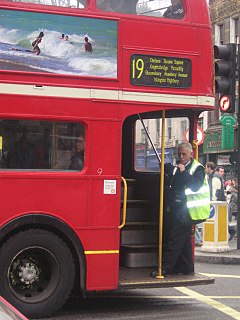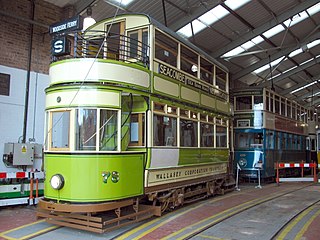
A bus is a public transport road vehicle designed to carry significantly more passengers than the average cars or vans. Buses can have a capacity as high as 300 passengers, although the average bus usually carries between 30 and 100. The most common type is the single-deck rigid bus, with double-decker and articulated buses carrying larger loads, and midibuses and minibuses carrying smaller loads. Coaches are used for longer-distance services. Many types of buses, such as city transit buses and inter-city coaches, charge a fare. Other types, such as elementary or secondary school buses or shuttle buses within a post-secondary education campus, are free. In many jurisdictions, bus drivers require a special large vehicle licence above and beyond a regular driving licence.

The AEC Routemaster is a front-engined double-decker bus that was designed by London Transport and built by the Associated Equipment Company (AEC) and Park Royal Vehicles. The first prototype was completed in September 1954 and the last one was delivered in 1968. The layout of the vehicle was conventional for the time, with a half-cab, front-mounted engine and open rear platform, although the coach version was fitted with rear platform doors. Forward entrance vehicles with platform doors were also produced as was a unique front-entrance prototype with the engine mounted transversely at the rear.

Buses have been used as a mode of public transport in London since 1829, when George Shillibeer started operating a horse-drawn omnibus service from Paddington to the City of London. In the decades since their introduction, the red London bus has become a symbol of the city.

A minibus, microbus, minicoach, or commuter is a passenger-carrying motor vehicle that is designed to carry more people than a multi-purpose vehicle or minivan, but fewer people than a full-size bus. In the United Kingdom, the word "minibus" is used to describe any full-sized passenger-carrying van or panel truck. Minibuses have a seating capacity of between 12 and 30 seats. Larger minibuses may be called midibuses. Minibuses are typically front engine step in vehicles, although low floor minibuses do exist and are particularly common in Japan. Minibuses may range in price from £2000 to nearly £100,000.

Arriva London is a bus company operating services in Greater London. It is a subsidiary of Arriva UK Bus and operates services under contract to Transport for London. It was formed in 1998 from a fusion of previously separate Arriva subsidiaries Grey-Green, Leaside Buses, Kentish Bus, London & Country and South London Transport. Operations are split between two registered companies, Arriva London North Limited and Arriva London South Limited.

A bus driver, bus operator, or bus captain is a person who drives buses for a living.

Bus conductors were a common feature of many bus services across Europe until the late 1970s and early 1980s. The main reason two-person crews were needed was that most towns and cities used double-decker buses for urban services. Until the 1960s, all double deck vehicles were built with front-mounted engines and a "half-cab" design, such as the familiar AEC Routemaster London bus. This layout totally separated the driver from the passenger saloons. The conductor communicated with the driver using a series of bell codes, such as two bells to start.

The AEC Regent III RT was one of the variants of the AEC Regent III. It was a double-decker bus produced jointly between AEC and London Transport. It was the standard red London bus in the 1950s and continued to outnumber the better-known Routemaster throughout the 1960s.

The Daimler Fleetline is a rear-engined double-decker bus chassis which was built between 1960 and 1983.

The Oxford Bus Museum is a transport museum at Long Hanborough, West Oxfordshire, England, about 4 miles (6.4 km) northeast of Witney and 7 miles (11 km) northwest of the city of Oxford. The museum houses a collection of 40 historic buses and coaches, the remains of four horse trams and a replica City of Oxford Tramways Company tram.

Wirral Transport Museum is a museum situated approximately 0.5 miles (800 m) from the Mersey Ferry service at Woodside, Birkenhead, England.
Open top buses are used in the United Kingdom for sightseeing and seasonal summer services.

Buses play a major role in the public transport of the United Kingdom, as well as seeing extensive private use. While rail transport has increased over the past twenty years due to road congestion, the same does not apply to buses, which have generally been used less, apart from in London where their use has increased significantly. Bus transport is heavily subsidised, with subsidy accounting for around 45 per cent of operator revenue, especially in London.

The AEC Swift was a rear-engined step entrance single-decker bus chassis manufactured by AEC between 1964 and 1980. The chassis design was closely related to the Leyland Panther. It was available in 33-foot (10 m) and 36-foot (11 m) lengths, with an AEC AH505 or AH691 engine.

Trathens Travel Services was a Devon (England) based bus and coach operator, taken over in 1996 by Scottish-based Park's Motor Group. The family owned group came to national attention after running express coach services from Plymouth to London, in light of the Transport Act 1980.
GAC Ireland was a bus and coach manufacturer based in Shannon, County Clare, Ireland. It traded from 1980 until 1986, and almost all the vehicles it built were for the Irish state-owned transport company Córas Iompair Éireann (CIÉ) with the first delivery out of a 749 order in November 1980.

The Daimler Freeline was an underfloor-engined bus chassis built by Daimler between 1951 and 1964. It was a very poor seller in the UK market for an underfloor-engined bus and coach chassis, but became a substantial export success.

The Reading trolleybus system served the town of Reading in the English county of Berkshire and was owned by Reading Corporation, who had operated an electric tramway since 1901. As there was a need for major refurbishment of the tramway in the 1930s, they decided to replace it with a trolleybus network. The first route was converted on 18 July 1936, and by mid 1939, trolleybuses were running over most of the tramway routes, with the last tram running on 20 May. By the standards of the various now-defunct trolleybus systems in the United Kingdom, the Reading system was a moderately sized one, with a total of four routes, and a maximum fleet of 63 trolleybuses, a size that lasted from 1 December 1950 to 27 March 1952.
The Leyland Royal Tiger PSU was an underfloor-engined bus and coach chassis manufactured by Leyland between 1950 and 1954.

Coventry Corporation Transport was the operator of trams and motorbuses in Coventry, Warwickshire from 1912 to 1974. The operations of Coventry Corporation Transport passed to West Midlands Passenger Transport Executive in the local government reorganisation of 1974.






























